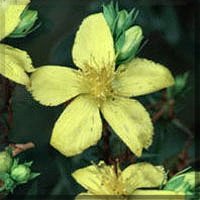
Hypericum perforatum

Hypericum perforatum
Origin - Worldwide
Part of the plant used - Aerial parts
Description - St. Johnís wort is a perennial with regular flowers which bloom from June until September. The plant was believed, from the time of the ancient Greeks until the Middle Ages, to ward off witchcraft and evil spirits and to drive out devils. Considered a noxious weed by farmers due to its photosensitizing effect on livestock, St. Johnís wort has nevertheless been used by humans for centuries for a wide variety of ailments, including nervous disorders, depression, neuralgia, wounds and burns, kidney problems and for its antibacterial and anti-inflammatory actions. Recently, a great deal of attention has been placed on the herb because of its two main active ingredients, hypericin and pseudohypericin, which have been shown to inhibit the AIDS virus.
Pharmacology - St. Johnís wort contains a variety of active ingredients including dianthrone derivatives (hypericin and pseudohypericin), xanthrones, flavonoids and tannins. Xanthrones and hypericin have been shown to have monoamine-oxidase (MAO)-inhibiting activity. A standard treatment for depression uses MAO inhibitors to retard the breakdown of neurotransmitters such as norepinephrine and serotonin and thus increase concentration in the central nervous system. A clinical trial involving standardized hypericin extract showed improvement in depressive symptoms, including anxiety, apathy, insomnia and feelings of worthlessness. The flavonoids and possibly other agents have wound healing and anti-inflammatory activities. Most current research has focused on the antiviral activity of the anthrowuinones, hypericin and pseudohypericin. Hypericin is a photodynamic red pigment whose antiviral activity is substantially enhanced by exposure to light. The mechanism is thought to involve the production of oxygen free radicals which can damage the viral envelope. Non-enveloped viruses such as polio or adenovirus are unaffected by hypericin.
Medinal Uses - St. Johnís wort has been used for centuries to calm the nerves and treat depression. A vivid red oil made from macerating the flowers in vegetable oil has been used to dress wounds, heal deep cuts, soothe burns and ease the pain of neuralgias. Taken internally, the oil has been used for ulcers and gastritis. An infusion of the herb has also been used as an expectorant for bronchitis and as a diuretic for the kidneys and as an easing agent for menstrual cramps.
Historical Uses:
Toxicity, Cautions & Contraindications - Consumption of hypericin may render the skin photosensitive. Care should be taken during exposure to sunlight. Avoid excessive exposure to sunlight, tanning lights or UV sources.